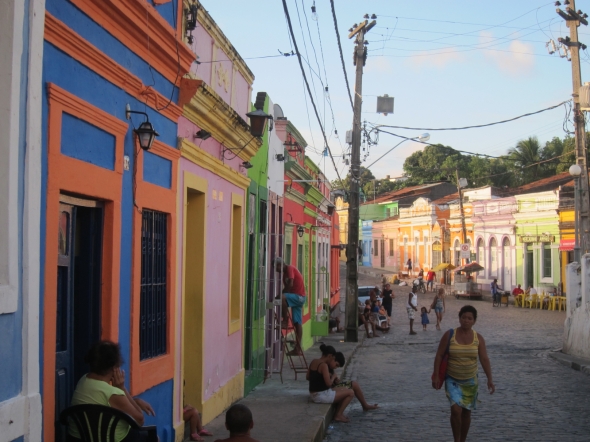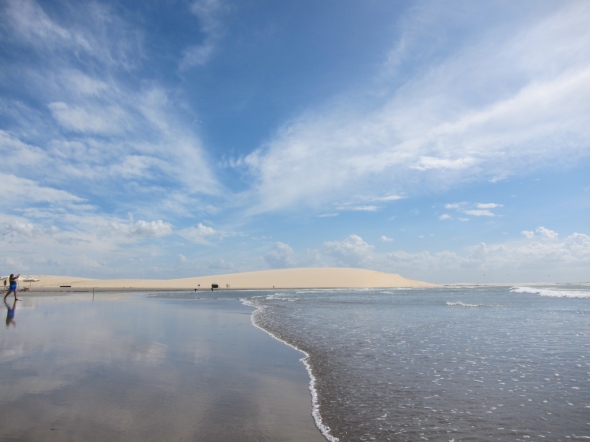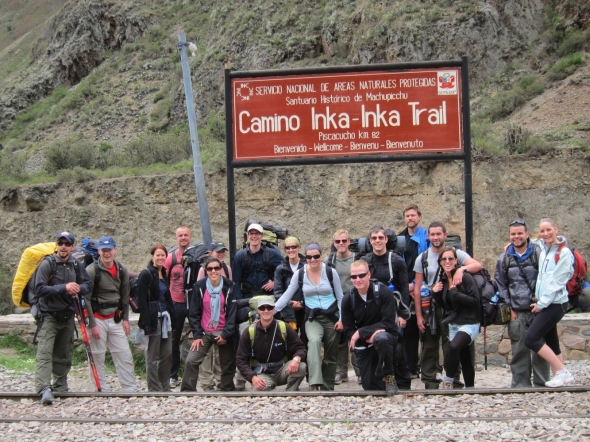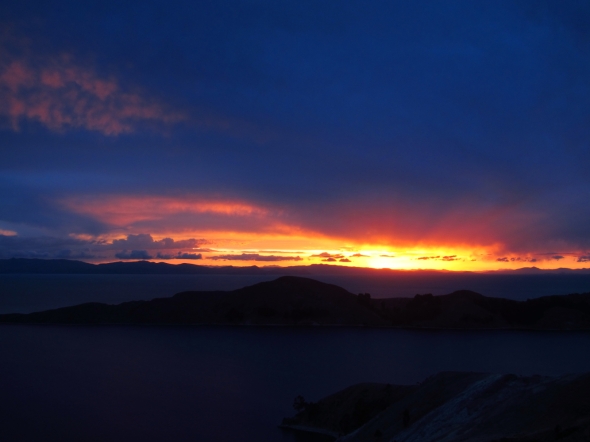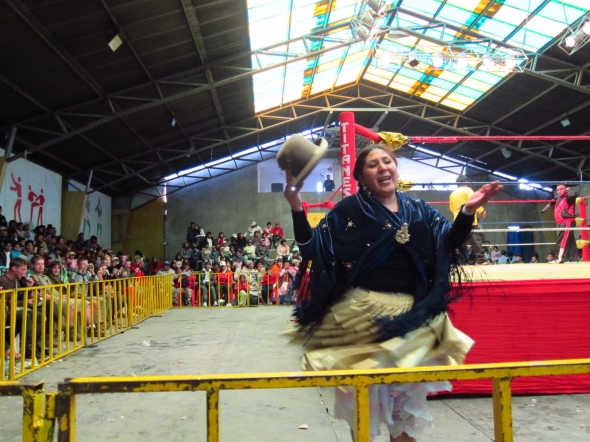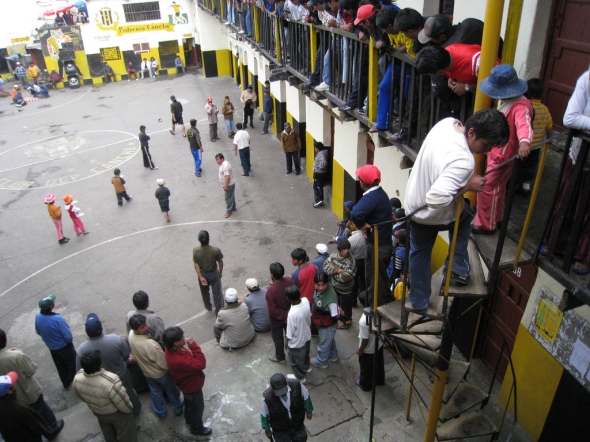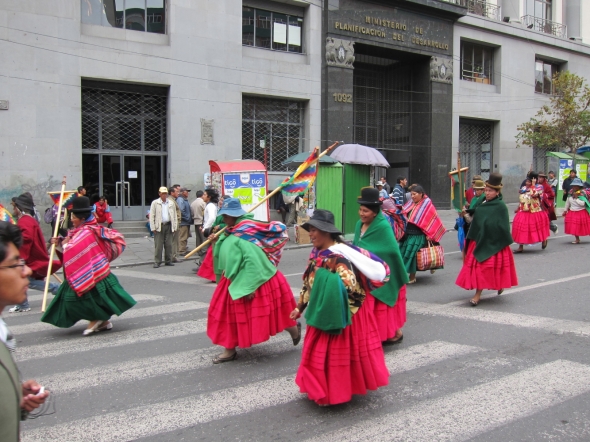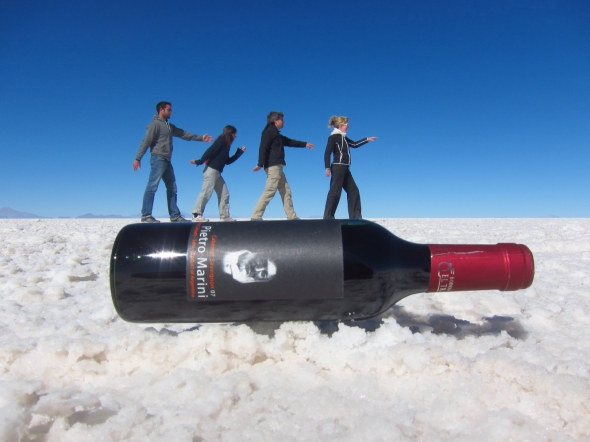Cheese AND Banana?

Another delayed flight finally took us from Fortaleza to Recife. While the city itself is pretty grim (and has the highest crime rates in Brazil), the surrounding area is stunning. Olinda lies on the outskirts of Recife and is a hub of creativity where artists, sculpturs and designers set up their studios and galleries. The pretty town is perfect for the arty vibe with colourful houses lining the streets. Although it only takes a day to wander the whole of Olinda, many hours can be taken up checking out all the different galleries. It must also be noted that Olinda is where we discovered the calorific Cartola Tapioca – cheese, bannana, condensed milk and cinamon in a Tapioca mmmm. We were slightly reluctant to try the banana and cheese combo at first but it really works!
Our bus to Porto de Galinhas was meant to be straight forward but we found ourselves waiting hours in the back streets of the worst part of Recife with people sleeping on the street and no one speaking English. After fighting to get on the right bus (not easy with large backbacks) we were on our way but packed into a bus standing in the isle for over 2hrs…we hoped the journey would be worth it. Porta de Gallinas has lots of incredibly long beaches, some parts are packed out with vendours and Brazilian families but you can easily walk to quieter space. A short swim out from the beach are natural pools where we went snorkeling and saw so many beautiful fish. The rest of our time here consisted of gorgeous sun, jumping waves and drinking agua de coca…whist of course thinking of everyone back home in the snow.
Our bus back into Recife wasnt such a drama as on the way and after popping into South America’s oldest synagogue (partly forced to by Ronnie) we snapped up the last 2 seats on a night bus to Salvador. I dont mean to complain but we were positioned right by the toilets and good lord did it STINK!
Jericoacoara

After a somewhat tubulent (and yet again late) internal Brazilain flight, a long bus journey and a trip on bouncy ‘4×4 bus’ we finally made it to Jericoacoara. ‘Jeri’ as the locals refer to it is a small, isolated surfer town set between beach and miles of sand dunes. There are no real roads, so you can only get there by boat, buggy or the strange 4×4 bus we opted for. We befriended areally cool Dutch couple (Bram and Tara) on our journey into Jeri and ended up spending most of our time there with them – it’s easy to meet up with people in Jeri as there are only about three sandy ‘streets’ and several small adjoining streets, all lined with cute artsy boutiques, restaurants and surf shops. We soon stocked up on new beach wear and found our favourite sunbeds. When you take away the odd storm and Chris’ day in bed with a bad stomach (which was MUCH worse than Sophie’s bad stomach in the jungle) Jeri was a truly stunning place to sit back, drink agua de coco and enjoy the Brazilian vibe. We even got involved with a private salsa class (which has given Chris his new nickname ‘snake hips’), had a very poor attempt at sand boarding and enjoyed speeding over the sand dunes on a buggy. Jeri is one of the only places in Brazil where you can see the sunset over the horizon so everyone climbs the sand dunes to watch this ritual sunset followed by the quality Capoeira on the beach and enjoying cocktails from one of the stalls until the wee hours…this is where we discovered the kiwioska that is a new must-have for any cocktail party (kiwi + vodka = divine).
Rumble in the Jungle
Shortly after arriving in Manaus we were keen to leave – imagine rush hour on Oxford St (the cheap and horrid end), only 38 degrees and unbearably humid. Luckily we only had to spend the day there before heading into the Amazon with well reputed Gero Tours. We were a small group of 5 people including a German mathmatics genius and a Hollywood premadonna called Kyle. Several boat trips eventually took us to the Jungle lodge, where we slept in hammocks inside a spacious straw roof dorm. Every night the room filled with more bugs than you could imagine and several frogs in the bathroom soon became my friend. Each day our guide took us out for both morning and afternoon excusions to explore the Amazon. We learnt and did everything you need to survive in the jungle, from Pirana fishing in the pouring rain (Chris catching the biggest, Sophie catching a slightly stunned catfish), to treking through the forest looking at medicinal plants (quite incredible really and slightly peeved I spent £90 on our Malerone when you can chew a leaf for the same effect!). We also saw the forests deadly insects as well as stunning pink dolphins and sneaky looking caiman.
The trip wouldnt have been complete without being hit by a stomach bug. Having spent all night on the toilet trying not to wake the dorm, Sophie had to spend the morning in bed to recover. Chris went to see sloths which almost look like they belong in Sesame Street. Sleeping was pretty hard given the seriously loud sounds you hear at night especially the howling monkeys and a stunning sunrise made the lack of sleep well worth while.
The final highlight of the trip were a couple of cheeky monkeys coming into the lodge to grab as many bananas as they could handle…check out the video. Allthough the experience was an amazing one we were quite relieved to be out of mosquito infested land and a toilet that had a light switch (not Chris holding a torch for me).
… and Machu Picchu

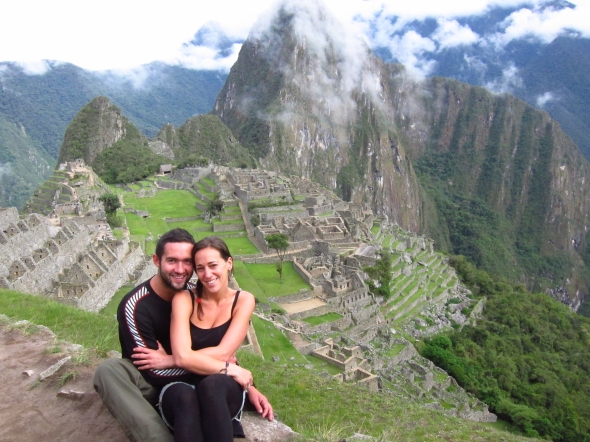
We made it. A 3am start meant we arrived at the ‘Sun Gate’ in time for sunrise, with the prospect of spectacular views of Machu Picchu. Unfortunately the ‘Sun Gate’ didn’t live up to it’s name and dense fog prevented us from seeing much until we descended a little further. As soon as the fog lifted and the ruins came into sight, the views were genuinely spectacular and well worth getting up for – particularly to get some shots of Machu Picchu before the bus loads of tourists arrived later that morning.
Machu Picchu was never completed by the Incas as they abandoned the site before the Spanish conquest. It’s estimated that around 500 people lived there (as well as the many visiting pilgrims) and around 2000 Inca’s were involved in building the site over a period of up to 100 years. The site remained untouched until 1911 when Hiram Bingham discovered the site whilst exploring other Inca ruins in the area. The Incas didn’t have any form of written language, so there are no documents or inscriptions relating to Machu Picchu, leaving a great deal of uncertaintly and mystery around the site. There are a number of theories around what the area was actually used for, although the general concensus is that it was a sacred religious site. Machu Picchu was recently voted one of the New 7 Wonders of the World…we’re now keen to see the other 6!
The Inca Trail

We hadn’t anticipated being able to hike the Inca Trail, as you usually have to book months in advance, but we were chuffed to find out we could get a place if we stayed in Cusco for a few extra days (albiet giving Lima a miss to get back on schedule – sorry Lima!). After four days building excitement in Cusco we finally set off on the Inca Trail laden with ALL the necessary gear.
Our group was an eclectic mix of Europeans who, lucky for us, spoke English. It was early into the trip we both realised that this wasnt the ‘walk in the park’ excusion we originally thought. It turns out the Inca’s were determind people and walked through several valleys and up large mountains to get to the sacred Machu Picchu. 4 days of fun turned into 4 days of tough walking (mainly due to the weight of the bags on our backs) but we loved every minute. The scenery was stunning and the Inca sites were fascinating (‘tambos’ resting sites, agricultural land and religious temples) which made the trail well worthwhile. It was great to hear about the Incas from our guide who, as an Incan descendant was truly passionate about the history. It was also amazing to see the porters rushing past us lugging up the mountain all our food, gas and tents. Whilst we panted and perspired with our 10kg bags, these guys almost ran up the trail carrying 20-25kg… quite incredible. 3 nights in a tent, 3 early starts, several layers of thermal clothing and one ‘luke warm’ shower, and we finally earned our place in Machu Picchu…
Lago Titicaca

Lake Titicaca, South America’s biggest lake and the world’s highest. We decided the best way to see the lake was to stay on one of its islands with a local family. Im not sure where else in the world you can get a double room for £2/night. Mind you, you don’t get running water or heating and you have to bring your own loo roll. We took a boat from Copacabana to the ‘Isla Del Sol’, which takes nearly 1hr 30 by a painfully slow boat. When you arrive and climb the steep hike up the ancient Incan stairway, you are rewarded with some of the most spectacular views of the lake. Although there is very little to do on the island, the views make it well worth the visit, as well as several inca ruins and long island walks, which, at 3800m were no walk in the park. Lake Titicaca sits on the border between Bolivia and Peru, so it was our last destination in Bolivia as we moved in to Peru…
Cholita Wrestling

We couldn’t resist the temptation of ‘Cholita wrestling’, where we were told we could see traditional Cholita women fighting. The wrestling was truly tacky but brilliantly entertaining. Front row seats were a bonus as the wrestlers interacted with the crowd (throwing apponents on the audience), and audience participation (throwing things back… anything you liked) was encouraged.
San Pedro Prison

We had heard much speculation about the possiblity of ‘tours’ around one of South Americas most notorious prisons. Ask any locals and they will tell you that you can no longer gain entry into the prison, but on arrival at the hostal in La Paz, we met a couple who heard tours were still possible on the weekends so long as you bribed the guards. We were in luck…it was a Saturday! Although the whole process sounded a little dodgy, accounts of the prison were incredible, so we headed in the direction of San Pedro square where sure enough we were appraoched by a guard asking us if we wanted to enter. One by one we slipped pasted the entrance and handed over our ‘bribe’…we were in! Our tour guide/inmate Mike took us through most of the prison sections. Rest assured we had guards with us at all times, although later found out these guards were inmates with life sentences… great. The whole prison (male only) is corrupt and run by money. Those with lots of money can have a large cell with TV, kitchen and bathroom while other with little money can barely last the night. Wives and children live there as a family as life in the prison is considered better than outside as this is normally all they can afford. There are also restaurants, gyms and saunas in the ‘luxury’ sections of the prison. Asking Mike what he did to get inside he replied ‘I killed someone’. Hmmm wasn’t sure what response one gives to that, especially when he reveals a large stab wound under his t-shirt from a fight he was in a month ago. Mike introduced us to his wife and told us she was pregnant and he hoped to be out the prison within a year. Not sure if he was high on something or getting too much money from tourists to bribe a judge but we didnt have the heart to question this assumption. We were just glad that after our 2hr tour we were able to slip out the gates and leave the most bizaare prison on earth behind us.
Needless to say we weren’t allowed a camera inside the prison, so we only have a postage stamp as a souvenier and some pics from the web…
La Paz

La Paz was one of the most intense cities we’ve visited; a manic 24 hour city, which is loud, dangerous, smoggy and busy. At 3660m, you certainly feel the altitude as well as everything La Paz throws at you. Set high in an Andean valley, the main street (El Prado) runs through the centre, with the city growing up the mountains on either side. This makes navigating quite simple as wherever you are, you simply walk down hill to El Prado and find your bearings. Walking also makes a lot of sense as the roads seem to be constantly blocked with traffic (one 10 minute taxi drive took us literally 5 metres round the corner before we gave up!), however the steep incline of the streets can make going anywhere impossible on a hangover! Protests, apparently, are a daily occurance and cause complete chaos by closing one half of ‘El Prado’. The city’s architecture is mostly dull, decaying and dusty, but is contrasted by colourful people (particularly the traditional ‘cholita’ women) and numerous markets. The Withches Market was particularly worth visiting to see the Llama foetuses and other oddities on sale for use in ceremonies. La Paz is known as a bit of a party town, so we took the opportunity to take in some nightlife with other travellers.
Salar de Uyuni pt. 2

More stunning scenery on day 3 (and a slightly tired and grumpy Sophie). We were able to get really close to the flamingo´s on one of the beautiful lagoons as well as Vicuña, Llama and Alpaca. Reaching the edge of the Salar De Uyuni by dark we spent the night in a Salt ´hotel´. Everything from walls, flooring, tables, chairs and beds were made from salt (good for Sophie´s ulcers) and we even had our first shower. Tonight it was Sophie that cut the village power by attempting to plug in a hairdryer (genuinely!).
Our final day started at 4am (IN THE DARK) to make our way to the middle of the salt flats for sunrise… a one-off experience well worth the effort. Its hard to describe the scale of the salt flats at over 11,000sq/km and to believe that under the hard salt crust (1m-20m thick) lies vast amounts of water. We visited one of the 14 islands in the salt flats which is home to some acient cactus and provided stunning views. Breakfast must be mentioned here….freshly baked bread and pancakes from our fabulous cook who had clearly been up earlier than us that morning.
Given some of the stories we had heard about bad tour companies we were so lucky to have a great guide, cook and fellow travellers…
Salar de Uyuni pt.1

The largest salt flats in the world at 3650m above sea level. We arrived in Tupiza just in time to book ourselves onto a tour for the following day. By chance we teamed up with another couple who were really lovely from Holland which was lucky as we were spendng the next 4 days and 3 nights sharing bedrooms and a cramped 4×4 with them! Both Santos our tour guide and Janet (our cook) only spoke Spanish so we were once again maxing the phase book.
Day 1 we headed into the mountains reaching 4200m. We passed several remote villages (how do they get their post!) finally arriving in San Antonio De Lipez (4260m) to spend the night. The food was fantastic and with coco leaves, vino and backgammon all was going well… until we discovered we nearly hit the floor on the seriously old matress and Chris caused a village power cut trying to charge his camera!
Day 2 and we were feeling the altitude with banging headaches among the group. Today was our favourite with inca ruins, old mining villages, first sightings of flamingos (love love love), colourful lagoons, desert landscapes and hot springs (bliss). The Laguna Verde although looked inviting with its colour was actually given its colour by the high arsenic content (so swimming was off the agenda). At over 5000m the freezing temperatures set in for the evening (as well as Sophie´s night-long headache). When the power was suddenly cut at 8pm we were forced to bed early.
Potosi & The Silver Mines

Potosi is a fascinating city. At 4100m above sea level it is the highest city in the world and has an incredible if not tragic past. The only reason for Potosi existing as a city was the 1545 discovery of silver in the Cerro Rico mountains and the consequent ´silver rush´ led by the Spanish. The population of Potosi grew from nothing to 160,000 within 50 years as the Spanish extracted the silver. Conditions for the slaves in the mines were quite terrible, with an estimated 9 million fatalities over 300 years of mining. A local told us that if you took the bones from all the bodies in the mine, you could build a bridge from Potosi to Spain. They also say you could build a similar bridge with the silver that has been taken over the years.
Today, Potosi still has remenants of the silver rush with some amazing colonial architecture. The mine still operates in a similar way to its past although silver is far less available and other minerals such a zinc and lead are also extracted. We were able to visit the mines with a former miner who showed us the whole mining process. On route we stopped at the miners market to buy them gifts as it is not an “official” tours and we must respect this is still a place of work for the miners. We were stunned to find dynamites available for 50p on the same shelf as a bottle of coke. There is also 96% alcohol on offer which Chris took up the offer of trying (probably to calm his nerves pre entering the mines). We asked if there are any age restrictions for buying both alcohol and dynamites but apparently none exisit!!!! Armed with said goods we headed for the mines, kitted head to toe in the full uniform (Chris looking like Bob the Builder and Sophie swamped with the overalls). Heading into the mines was nerve-wracking with only light from our head torches and the hot air filled with heavy dust. Even without suffering from claustraphobia it was impossible not to feel the pressue of being so deep underground. We crawled through tight tunnels and dodged the rickety mine carts amazed to see how old fashioned things still are. We spoke to different miners at work, all with cheeks full of coco leaves and ages varying from 16-60! After 2hrs spent in the mines we were happy to see daylight at the end of the tunnel!
Disco in the Puna

The next trip involved a crazy guide called Juanjo (that’s Wanko in English) who was addicted to coco leaves and disco music. It was quite surreal (but very enjoyable) speeding around the mountains listening to Abba (in spanish) and E.L.O. He took us to some of the highest peaks we’d been to in Argentina (up to 4500m) where we began to discover the meaning of altitude sickness.
The tour followed part of the route of the ‘Tren a los Nuebes’ (train to the clouds), through the puna and on to the salt flats. A ‘puna’ is simply a desert or plateau over 3000m, to put that in perspective Ben Nevis is 1344m at the summit. The Salt Flats were quite incredible, thick enough to drive accross and stretching as far as you could see. The workers who extract the salt get paid next to nothing and often loose their sight as the salt acts like a huge mirror reflecting the sun. En route to finishing the tour in Purmamarca, we descended over 2000m in just 16km of very steep, windy mountain road – with a Phil Collins soundtrack of course.
The night was spent in Purmamarca, finally finding a decent room after doing a runner from our first one. Pumamarca is incredibly small made up of a few dusty streets… not the ideal place to try and call parents and got several weird looks when asking for ‘wi fi’. Several bottes of wine later and some local folk entertainment we had a good night and much needed sleep. Purmamarca is home to the ‘Cerro de los Siete Coloures’ (the mountain of seven colours) – absolutely stunning in the morning sun.
Now where’s the bus to Bolivia?
Valles Calchaquies

The Valles Calchaquies are one of the most spectacular landscapes of the Andes. Setting off from Salta and heading to the small town of Cachi and then on to Cafayate we travelled in a 4×4 on a 2 day tour. Our guide spoke little English so we were forced to imporove our Spanish. He gave us our first taste of coco leaves which are incredibly popular here…not sure what to make of them but the taste was pretty gross. The landscape changes dramatically from grassy mountains to red rock cliffs and enourmous cactus forests. We spent the night in Cafayate and found time to do a spot of wine tasting and visit a goats cheese farm. The wines of Cafayate differ from what we had previously encountered in Mendoza. With the higher altitude and different minerals in the soil, Cafayate is best suited for producing the white wine ‘Torrontes’, although there are still good reds to be found. A small ice-cream shop also sells novel Malbec & Torrontes ice-creams.
Salta

Another 17hr bus journey took us to the northern Argentinian town of Salta. The people of Salta look much more indigenous than those of Buenos Aires and Mendoza, which are far more western-ised. The town itself has some beautiful colonial buildings and tons of great Parrilla´s and Puñas ( traditional restaurants and pubs with folklore music and dancing ). The town is popular with tourists as a starting point to explore the Argentinian Salt flats and the Valles Calchaquíes.
Meat, Malbec, Mendoza

We’d love to tell you we did more than drink wine and eat steak during our stay in Mendoza – but we didn’t.
Three days of quality wine and the biggest steaks, what more could we ask for. Well maybe not the 38 degree heat we were hit with on the last day but netherless we thoroughly enjoyed ourselves. As soon as we arrived (after a 14 hour overnight bus trip) we headed to the vineyards for a tour of the wine making process and of course to sample one or two. After a visit to a chocolate and liqueur maker who gave us adequate shots of various alcoholic substances we left pretty fueled up. We had a great lunch (more wine) and then head to a beer garden we spotted on our local map; situated in the middle of nowhere amongst miles of vineyards. Needless to say this place was also discovered by several other Brits in the area. We had great time drinking beer and wine, not sure exactly how the day ended but it involved Sophie screaming on the back of a bike while Chris cycled home with a group of Brits… and a friendly police escort.
Day two and its more wine tasting, this time learning how to smell different flavours and what to eat them with (come dine with me here we come). More fantastic food, vino a short nap in the Plaza and we were fully settled in the chilled out vibe of Mendoza.
Now having both South Africa and Argentinia wine tasting under our belt we are fully equipped to take on any wine list. The only issue being how many of them we can find in the UK – as the world’s 5th largest wine producer Argentina only exports around 20% of it’s wine, which is a little greedy.
Cementerio de la Recoleta
We spent our final day in Buenos Aires visiting Recoleta, including the famous cemetary where Eva Peron (Evita) is buried. At first the whole cemetary could almost look like miles of abandoned buildings (see picture), until you look inside and see the coffins… The cemetary is 60,000 square metres and arranged very neatly in squares with tree-lined avenues inbetween. Obviusly burial is hugely important in the Catholic faith and the mauseleoms here are testemant to that, many of them incredibly elaborate and grand. The flowers on the Evita tomb (with her family in the ‘Durante’ mauseleum) are a reminder of how important she still is to the Argentine people, in Argentinian politics today there is still frequent reference to the ‘Peronist’ era (when Juan and Eva Peron ran the country) and politians and policies are often dubbed ‘peronist’ or not.
A fascinating if not eerie experience.
Cementerio de la Recoleta
A day on the Delta

A local guy we met on the plane recommended we take a trip to the Paraná Delta, so we did just that. 1hr outside B.A we arrived at Tigre, which is the furthest place connected by road and rail on the Delta. The Delta is an amazing place, half the size of Switzerland but with only 8,000 people living on island homes along the complex river system (although most of these are holiday homes for people who work in Buenos Aires, so during the week many of them are unoccupied). Map of the Paraná Delta below:
We took a water taxi and travelled through the delta past many houses (only accessible by boat) arriving 1hr from land at a wonderful Island called ‘Bonanza’. A lady lives here, and with the help of a Gaucho to assist with the horses, she invites people to join her for a day of activity. We had a lovely lunch by the river (more meat), followed by horse riding (Chris failed to mention he didnt know how to ride and created much amusement trying to steer the horse), a swim in the fresh water, and finally a go at canoeing. The weather was well into the 30’s and a day by the river was perfect.
La Boca

La Boca is the poorest yet most colourful part of Buenos Aires, the streets filled with Tango dancers, cafe’s and brightly painted buildings. Apparently the paint originally came from the cargo ships in the port of La Boca (La Boca is also known for it’s iconic iron bridges at the port). As there was only the odd tin here and there people would paint small sections of the buildings, hence the patchwork look. La Boca is home to Boca Juniors football club, and there is an incredibly strong love of the team throughout the area. We visited the stadium which isn’t that large but apparently holds 65,000. It’s amazing how close the fans are to the pitch, literally about 5 feet behind the goal in the standing areas. Despite being the poorest area in Buenos Aires and having the higest crime rate, La Boca seems to have a lot going on in terms of art and culture (including the Fundación Proa) – quite like East London in some ways.
¡Hola Buenos Aires!

Buenos Aires; the start of our South American adventure. We were immediately stuck by the vibrant atmosphere of the city… lively people, vivid colours, tango and history. A completely different city experience to Cape Town, Buenos Aires is much bigger, older and almost entirely flat. It feels a lot more like a european city, with a mix of old buildings and ultra modern architecture, and being built on a grid system. It also soon became apparent that the residents of Buenos Aires are very proud and passionate about their city and country. We flew in just days after former president Nestor Kircher had died, and the city was full of posters and graffiti mourning him and supporting his wife Christina. It’s hard to image similar scenes if a British political figure were to pass away.
On arrival we were told that Sunday was market day in Palermo, the chic and stylish area of BA filled with small boutique shops. On market day many of cafe’s and bars are also converted into make-do stalls where independant designers and traders sell their goods. Needless to say I made Chris drop the bags immediately and head straight there for the remainder of the day. We returned several hours later with more clothes to fit into our already full luggage.
We spent the following day in San Telmo, the oldest part of the city which has tons of character with piqturesque cobbled streets and plazas lined with dusty antique shops and cafe’s. Chris found much excitement in the ornate hand-painted signs on everything from shops to buses. After a gruelling 2hr Spanish lesson we head to Puerto Madero , a modern harbour deveopment (not dissimilar to London’s South Bank) for an evening walk and dinner. Dinner consisted of a large steak and a nice bottle of wine – this was to become a consistent theme in Argentina…
Goodbye Cape Town

The past month has flown by and it was now time to say goodbye to friends (old and new). On our last day at school we were made to feel very special, recieving more cards than the Girls Aloud fan club and being swamped with hugs and marriage proposals. We made a small thank you speech in the assembely to the 550 kids and gave out lollipops as a Friday treat. Its strange that altough we’ve only been at the school a month we feel we have got to know some of these kids so well and felt both guitly and sad to be leaving them.
We had a lovely farewell meal with Syl and Ray at the Waterfront and have loved seeing them so much. Its also been amazing to spend lots of quality time with Darren and Kirsten (her baby bump growing even more during the time we have been here – 5th Dec is not far away now). Very strange but exciting that they will be parents when we are next in Cape Town.
Bye friends, bye Vrygrond, bye Cape Town. Buenos Aires here we come…
Life in Vrygrond
Just a few snap shots from Vrygrond. We didn’t take many pictures here as it’s not the sort of place to flash a camera around. We passed the fire on the way to school one morning, apparently a woman had caught her husband cheating so had burned all his clothes outside their home. Hell hath no fury…
The video is from sunrise crèche, and shows the amazing contrast between what the kids experience at the creche and in the neighbourhood:
Wine glorious wine

A day off from school and a scorching hot day we headed for the winelands of Cape Town. Making our way from Stellenbosh to Franschoek, the sceneery was stunning and we tasted our way through several wineries, even spoiling ourselves with a cheese board. Chris now thinks he’s the connesiur of South African wines and I’m wondering how we’ll ever go back to the £5.99 bottles we used to buy in Tesco!
False Bay (The Southern Peninsula)

The Southern Peninsula is often overlooked and doesn’t have the best reputation, but after staying there we decided it was one of our favourite areas of Cape Town. We stayed in Muizenburg mainly out of convenince (it’s not too far from the school in Vrygrond), but soon became quite happy with the laid back, surf-orientated lifestyle it had to offer. A short but stunning run along the coast took us through St.James and on to Kalk Bay (now our favourite spot in Cape Town). It has a great selection of boutique shops, cafe’s and restaurants and all with an authentic quirky vibe. Further round the bay Fish Hoek, Simon’s Town and Boulder are all also well worth a visit. False Bay seems to have avoided much of the 70’s concrete development that other areas of Cape Town have fallen victim to… maybe why we liked it so much… that or the breakfast at Olympia Cafe.
